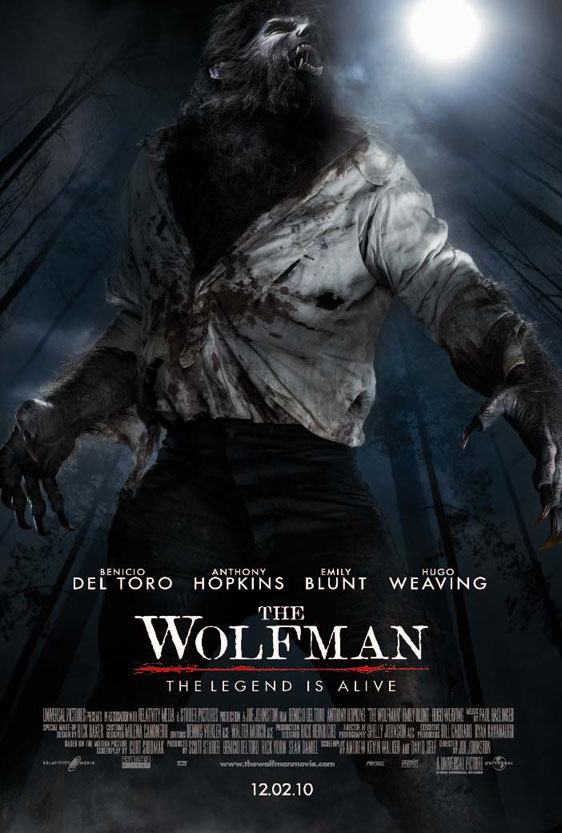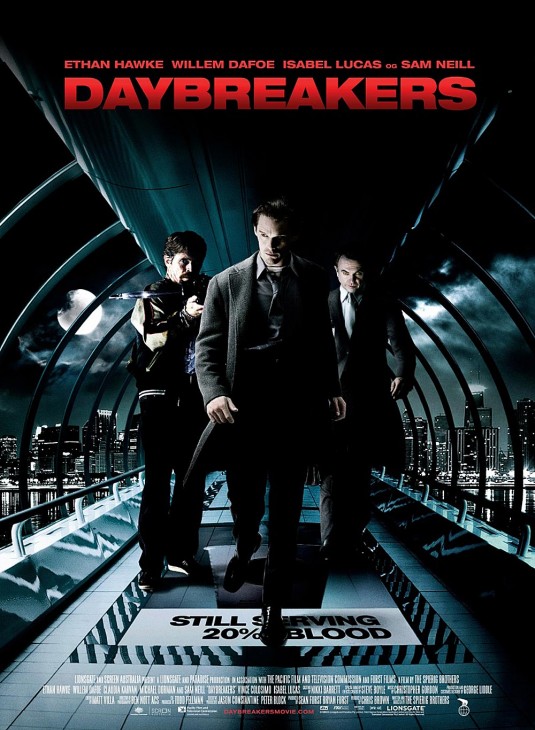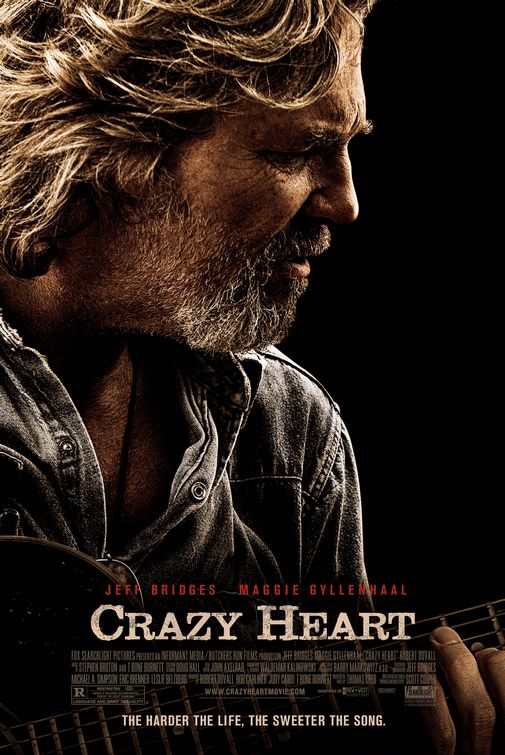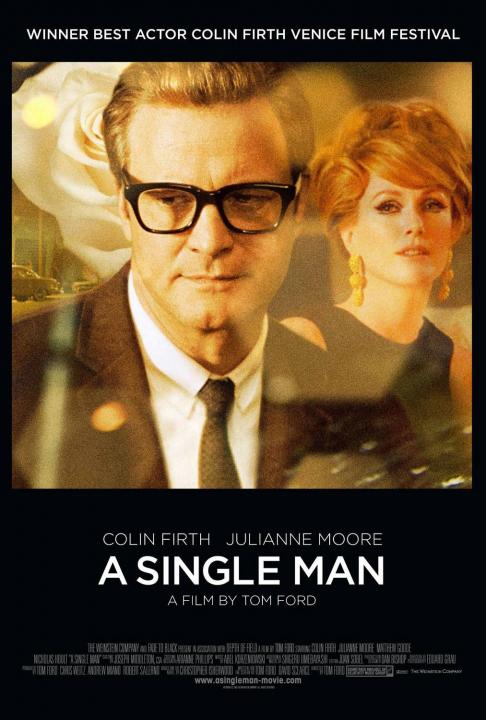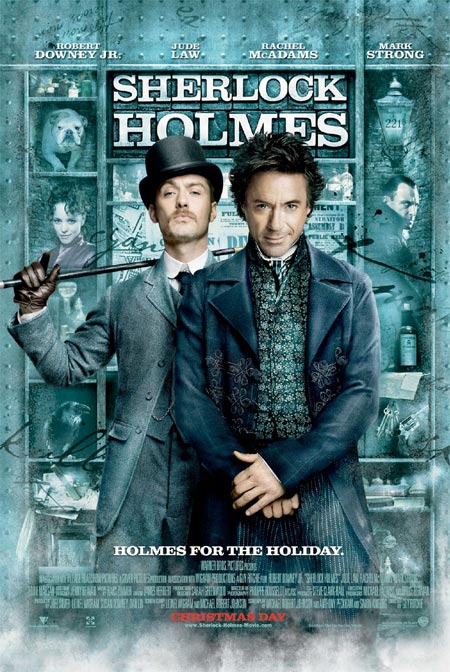Status: In theaters (opened 2/12/10)
Directed By: Joe Johnston
Written By: Andrew Kevin Walker and David Self
Cinematographer: Shelly Johnson
Starring: Benicio Del Toro, Anthony Hopkins, Emily Blunt
I suppose it’s sort of unfair to fault a remake for being unoriginal, but the bottom line with The Wolfman is basically that it feels like every other werewolf movie that’s preceded it. Maybe this is because the original—1941’s The Wolf Man— has been frequently imitated, or maybe it’s just because there’s not much that can be done with a werewolf story. The one novel attempt I can think of is the Jack Nicholson vehicle Wolf, which didn’t really work. This newest incarnation of The Wolfman is much more traditional: it takes place in the late 19th century, in England, and centers around local legends that turn out to be true. Benicio Del Toro plays Lawrence, the estranged son of a landowning nobleman, Sir John Talbot (Anthony Hopkins). As the movie opens, Lawrence’s brother has been found maimed to death in the woods, and he’s received a letter from his brother’s finacee (Emily Blunt) beseeching him to return home to help investigate. (Lawrence, it seems, has been in America since he was a child, which works out well for Del Toro, who happens to be able to do a serviceable American accent.)
Lawrence reconnects with his father, and finds the old man to be aloof and mysterious, to say the least. His investigation leads him to a band of gypsies. There’s always gypsies in a story like this. They know all the legends, and how to interpret them. Lawrence eventually, it should go without saying, contracts the curse. Director Joe Johnston does a good job of slowly revealing Lawrence’s werewolf persona—it’s more startling to only see him in glimpses in the dark than it is to get a fully-lit view of him, but of course eventually that must happen. And when it comes down to it, any werewolf movie is going to end up with a guy in a mask jumping around and howling at the moon, and maybe that’s why it’s hard to do much of anything unusual with them. So it goes.
Gwen (the fiancee) does some digging of her own. She finds a book—there’s always a book—that gives a quick overview of how werewolves work, and what it takes to stop them. How convenient. The local constable (Hugo Weaving, in his dominant baritone) gets in on the chase. At times the werewolf is out in the open, being chased through the streets or across the rooftops. At others, he’s lurking in the forest, and the smallest rustle elicits a nervous jump—not just from Gwen, but from the audience, too. And sometimes we’re expecting a werewolf to jump out of the shadows, but it ends up only being Sir John’s dog. When we’re most poised to be scared, it’s always the dog.
It turns out there are actually two werewolves terrorizing fair Blackmoor, and The Wolfman‘s climax is the inevitable battle between them, which Megan compared—accurately, and unfavorably—to the similar point in the Wolverine movie. Guys in hairy make-up, that’s more or less all it is, no matter how accomplished the actors underneath the costumes might be (and they are), or how good the CGI transformation effects might be (and they are). And as if to compensate for this fact, a movie like this always seems to know that it needs to go a bit over the top with everything else. Here the score, by the great Danny Elfman, is even a bit overbearing, and the violent imagery is cranked up to an almost absurd level of gore. It all goes with the fun, though: The Wolfman is a movie that makes no claims to be anything other than what it is—guys in wolf suits and all.
Status: In theaters (opened 1/8/10)
Directed By: Michael Spierig & Peter Spierig
Written By: Michael Spierig & Peter Spierig
Cinematographer: Ben Nott
Starring: Ethan Hawke, Sam Neill, Claudia Karvan, Willem Dafoe
It’s not hard to imagine what the initial spark of inspiration for Daybreakers must’ve been; there have been several releases in recent years that successfully turned the zombie-movie genre on its head in one way or another: 28 Days Later… made the zombies fast, Shaun of the Dead made them funny, I Am Legend [re]made them the majority. And for the past couple of years, vampires have been “in”—beyond the teenage girl craze of the Twilight movies and the decidedly adult guilty-pleasure craze of True Blood, there was also the very unique Let the Right One In from 2008 (a movie which, incidentally, I probably would’ve picked as the best film of that year, had I seen it prior to making my list).
So take all of these examples (and many more) together and it seems like the time should be ripe for a novel take on a vampire movie. (And in the interest of accuracy, I should mention that Daybreakers has been several years coming, though I think my reasoning above still holds when applied to its eventual theatrical release date.) The novelty in this movie—written and directed by a couple of Aussie twins known as the Spierig Brothers—is that vampires have become the majority. They’ve gone mainstream, so to speak; nearly everybody in this fictional near-future world has been “turned,” and the environment in which they live reflects it: the whole society functions at night, nobody fears death (smoking, it seems, has made a huge resurgence in popularity), and human blood is the most precious commodity. As with any alternate-reality film, learning about the specifics of Daybreakers‘ world provides for an enjoyable and intriguing first act—although I did think the Spierigs tried a little too hard to be clever on occasion. This vampire population, for instance, uses a “Subwalk” to get around during the day, leading me to wonder why they wouldn’t just take the train—it’s still underground, and thus out of the sunlight, right?
But no matter, what we’re here to learn about as Daybreakers opens is that Edward (Ethan Hawke) is a hematologist working for the premier supplier of human blood, a company called Bromley Marks. His boss is Bromley himself (Sam Neill), and everybody’s worried about the dwindling human population, and the impending blood shortage it implies. Edward begins to wonder if there might be a cure for vampirism, but Bromley doesn’t want to hear about that—harvesting and selling human blood to the vampire population has made him wealthy and powerful. Edward meets a couple of humans, Audrey (Claudia Karvan) and Elvis (Willem Dafoe), who believe they have discovered the cure he’s been looking for. And then the story is set up, and everything gets wonky.
Crucial to any story like this are the rules under which it operates, and its adherence to them. Daybreakers starts out abiding by this formula: There was some sort of plague of vampirism, which has resulted in most of the world being “turned.” Check. Such a large percentage of the population has become vampires that human blood is now in more demand than can be satisfied. Check. Vampires can turn humans into other vampires by biting them. Check. Vampires are immortal, unless they’re exposed to sunlight, or are the unlucky recipient of a wooden stake to the heart. Check and check. But then… well, it turns out that vampires who don’t consume enough blood turn into these weird-looking bat-like things. Okay, I’m willing to buy that. And, well, the sunlight doesn’t always kill them. And then there’s the way in which the cure that Dafoe’s character has discovered actually functions. To reveal the specifics would be to both spoil some of the movie’s surprises and also to demonstrate my lack of understanding of them, because frankly, it gets pretty hard to keep up with. There’s at least one twist too many, and the rules change too frequently, all for the sake of repeatedly turning the tables and catching the audience by surprise.
This is, admittedly, sort of a novel way to approach a vampire movie. The attempts at shock come not as much from scary things jumping out of the dark to startle you—though that does happen a few times—but rather from the story modifying itself as it goes in an attempt to change things up from the vampire lore we’re used to. This would all be well and good if it could just make up its mind about how the world of Daybreakers works, but it’s all so malleable that the audience can’t keep track of which rules are in effect at any given point.
It’s the kind of movie that makes you almost feel bad for the actors in it. Hawke and Neill give performances that almost feel out of place because they’re trying to take them too seriously. Willem Dafoe, on the other hand, is sufficiently over-the-top with his twangy Southern ex-vampire, in a tongue-in-cheek way that makes it hard to believe he kept a straight face when given his lines. The production value, too, is sub-par; I’ll never understand why movies at this current stage of technological development insist on using CG fire effects when it looks so damn bad, but Daybreakers can be chalked up as yet another example of one that’s fallen into this trap. There’s an over-reliance on CGI in general, in fact: one early scene involving an attempt by Hawke’s character to cure a fellow vampire went so far out of its way to use poorly incorporated graphics instead of regular old make-up effects that it took me out of the movie.
Daybreakers, basically, wants to be something it’s not. It’s a movie about vampires, but it’s not really a horror movie—it’d rather be a mystery about how this particular brand of vampirism works. And then it gets so wrapped up with that idea that it outdoes its own cleverness along the way, to the point of not actually revealing much about the mystery it began with. What’s left is a movie that has some fun and intriguing moments here and there, but doesn’t really satisfy on any front.
Comments Off on Rule Breakers
Status: In limited release (opened 12/16/09)
Directed By: Scott Cooper
Written By: Scott Cooper
Cinematographer: Barry Markowitz
Starring: Jeff Bridges, Maggie Gyllenhaal
There are some stories that’re good enough to be told many times without getting old. Crazy Heart falls into this category; its story is nothing particularly novel, but it’s told well enough that we don’t mind knowing where it’s going, and more importantly, following along on its well-known path is nonetheless an enjoyable experience. Adapted from Thomas Cobb’s book of the same name by writer-director Scott Cooper, Crazy Heart tells the story of Bad Blake (Jeff Bridges), a down-and-out, has-been country singer. He plays shitty little gigs, which he has to drive himself to in his ’78 Suburban (named, it should come as no surprise, Bessie). He has a drinking problem. He’s lonely. He has an antagonistic relationship with his manager (Paul Herman).
When Bad meets a beautiful music reporter who’s half his age (Maggie Gyllenhaal), he’s instantly smitten with her. She inspires him to try to improve his life. But oh, just when it’s looking like their unlikely coupling will pan out after all, he hits the proverbial rock bottom and screws up his chances with her (or does he?), and has his real awakening. His story becomes one of redemption, of finding one’s place in life after having already given up on it, of finding a purpose that had previously been lost. Sound familiar? Sure it does, but it’s a compelling story and it’s told well. We know the road Bad is headed down all too well, but we still want to see him travel it.
The primary reason for this, of course, is Jeff Bridges. He’s the kind of actor I can’t imagine anybody not loving—he was The Dude, after all. Bad Blake is quite a different character from the iconic Lebowski, but Bridges’ embodiment of him is just as defining. He not only gets to show off his acting abilities, he gets to sing, too—and can he. (You can sample this and his many other talents at his whimsical website, jeffbridges.com.) Bridges hangs it all out as Bad, and his performance, his depiction of this fully-realized character, is the movie’s main draw.
The supporting cast is equally up to the task of filling out the rest of the requisite parts. Maggie Gyllenhaal plays the typical Maggie Gyllenhaal role, and she does so in her typically endearing and strong Maggie Gyllenhaal fashion. Robert Duvall, too, shows up in a role that he seems like he’s been playing a lot in recent years, but his character adds a needed dimension to the story at just the right time, and he too is typically charming. Most impressive, though, is Colin Farrell as Bad’s former protege who has now far surpassed him in popularity and success. The Irishman plays a believable Texan, a character stuck trying to reconcile his aspirations with his loyalty. There are but a few scenes between Bridges and Farrell, but they’re all pivotal ones, and they flesh out the storyline as much as do Bridges’ key scenes with Gyllenhaal. Farrell, too, gets to show off some surprisingly serviceable country-singing chops.
Scott Cooper has generally good instincts for a first-time director. He knows enough to make Bridges’ musical performances a centerpiece of his film, but he also knows not to linger too long on them. We get a sense of how Bad performs at various stages throughout the movie, and we feel like we know what it’s like to be in his audience, but we don’t become restless in our desire for the story to keep moving. It’s mostly slowly-paced, but this fits with the overall mood, which Barry Markowitz’s cinematography complements well: it utilizes the Southwestern vistas to effectively establish Bad’s lonely place in the world, while at the same time showing how that same desolation can appear beautiful once your outlook on life has changed. The overall structure of the movie, though, feels a bit awkward, mainly due to a somewhat protracted third act. It almost seems like Cooper runs out of patience after painstakingly setting up Crazy Heart‘s resolution, and then rushes his way through it when it finally comes.
This is okay, though, because as I said, the story here is one we feel like we know already, and we only need a nudge to assume in which of two possible ways it’s going to play out. What gives Crazy Heart its identity, though, is its great acting performances, which are only overshadowed by its great music, by Stephen Bruton and T-Bone Burnett. They’re the kind of songs that seem like old standards, even though they were written specifically for the film. When the great acting and the great music are combined—particularly when we get to see Jeff Bridges croon out some of these songs—it’s a film that’s hard not to get into; you can’t help but want to allow it to take you down its road.
Comments Off on That’s Good, Bad
Status: In limited release (opened 12/11/09)
Directed By: Tom Ford
Written By: Tom Ford
Cinematographer: Eduard Grau
Starring: Colin Firth, Julianne Moore
You wouldn’t know it from the cheesy romantic comedies he usually appears in, but Colin Firth is a terrific actor. Particularly to American audiences, he tends to be billed as a Hugh Grant type—a snarky, handsome Brit who the leading lady can’t help but fall for—but in A Single Man, he gets a chance to show his real range, and he takes full advantage of the opportunity. It’s nearly a one-man show, and Firth completely commands the audience’s attention throughout.
The film takes place in the 1960s, and Firth’s character, George, is an affluent college professor who happens to be homosexual. As the story opens, we learn that he has recently lost his long-time partner in a car crash, and his attempts to cope with this loss form the crux of the film’s arc. His flimsy support system consists of his neighbors (Ginnifer Goodwin among them), with whom he has a casual yet uneasy relationship, and his long-time friend Charley (the always-great Julianne Moore). The majority of his coping is done in private, though, and it’s really amazing how much Firth conveys with little more than changing facial expressions and subtly-delivered dialogue.
A Single Man is based on a book by Christopher Isherwood, which Wikipedia tells me was considered “one of the first and best novels of the modern Gay Liberation movement.” Tom Ford, who’s apparently some sort of fashion designer, adapted it into a screenplay, and also produced and directed the movie. It’s an impressive debut into the film world. Keeping the story set in the 60s gives it a bit of distance from the current politicization of gay rights in our own times, and yet the movie still rings as relevant. In a time before gay marriage had even been a consideration, much less a publicly-debated issue, George had about as close as he could come to it in Jim (Matthew Goode), his lover of 16 years. As the story here takes place after Jim’s tragic death, George’s memories of him are often idealized—and what a great piece of casting to have Watchmen‘s Ozymandias, supposedly a perfect physical specimen, embody these memories.
Ford’s adaptation does an artful job of conveying George’s troubled emotions, though he does get a little carried away at times. There’s a water metaphor that is repeated throughout the film, and it’s mostly effective until it’s used one time too many. More subtle—and more effective—is Eduard Grau’s cinematography, which matches and complements George’s changing moods admirably, most notably by increasingly washing out the color saturation of the film as George contemplates and gets closer to suicide, and in contrast by turning everything bright and vibrant when he decides that he wants to live. There’re similar effects employed to help distinguish between George’s painful memories (bland and dim) with the times when he’s happy in the present (bright and colorful), such as in a pivotal scene with Charley where they reflect upon their lives and their failed attempts at finding happiness. The most effective device Ford uses, though, is to depict gays in general, and George in particular, as invisible, going not only disrespected but flat out unnoticed by their fellow citizens.
All of this works because of Firth’s performance, which runs the gamut of the emotional spectrum and conveys not just conflicted feelings and inner turmoil but a full realization of a human being with whom we can empathize. Following my above description of the film you might not believe me if I told you it was uplifting and joyful at times, but it is, and these moments counterpoint those of despair and gloom effectively. I think my favorite scene, though, was a pained phone call, where Firth tells his character’s entire story without uttering a word. It’s moving and difficult to sit through, so strong is its impact. Firth has been nominated for an Oscar for this role, and it’s quite well-deserved. More than just a showpiece for this performance, though—great and impressive though it is—A Single Man is a resonant tale told by a filmmaker on a mission to engage his audience while getting his point across, and Tom Ford does so quite effectively. This is one of those small movies that may be hard to find in your local listings, but it’s worth making the effort to seek it out.
Comments Off on Singularly Affecting
Status: In theaters (opened 12/25/09)
Directed By: Guy Ritchie
Written By: Michael Robert Johnson and Anthony Peckham and Simon Kinberg
Cinematographer: Philippe Rousselot
Starring: Robert Downey Jr., Jude Law, Rachel McAdams, Mark Strong
Pre-Sold Franchises—that’s what Hollywood execs call a movie that’s based on an existing property. The thinking goes that by securing the rights to an already well-known setting with familiar characters, they can be virtually guaranteed a certain number of butts in the seats. Sequels, remakes, reboots, and adaptations all fit into this category, and are generally considered a safe investment of production dollars. Sherlock Holmes is Guy Ritchie’s chance to tackle a pre-sold franchise, offering him the opportunity to bring 100-plus-year-old characters to new life with his frenetic filmmaking style. It’s sort of a period version of Snatch., but the results are a thoroughly enjoyable film with surprisingly broad appeal.
The take on Holmes (Robert Downey Jr.) by Ritchie and his screenwriters is one that assumes we’re already familiar with the character and his ever-present sidekick Dr. Watson (Jude Law), and enjoys playing with that fact. We don’t get the ever-present pipe, but we do see it on infrequent occasions. Ditto for the trademark hat, toned down here and joked about via direct reference in the introductory scene, as if the screenplay is saying, “Okay, let’s just acknowledge this up front so that the cliches don’t get in the way of the fun we’re about to have.” And so it goes. The plot involves an evil master of the occult named Lord Blackwood (Mark Strong) who plans to take over late-19th-century London, and Holmes’ attempt to stop him and bring him to justice. Along the way, the detective’s long-lost love (Rachel McAdams) shows up and becomes involved in the story as well. It’s a classic-style detective tale, one that’s believably rooted in the 1800s and yet somehow still lets you know that it knows that you’re watching it in the 2000s.
Ritchie’s stylistic flair is present here, though it’s more toned down than in some of his previous films, presumably to lower the barrier to entry and capture the attention of all of those pre-sold audience members. He allows for a couple of storytelling devices that embellish the straightforward storyline in creative ways, the most prominent and most enjoyable being his onscreen depiction of Holmes’ analytic mind. Just as the action gets going, we see it in slow motion, as Holmes imagines things playing out while planning his moves and thinking the sequence through in his characteristic level of detail. We then go back to the start and see things occur in realtime, witnessing the fruits of Holmes’ mental labor as the set piece unfolds. This is slightly confusing the first time it’s used, but by the film’s climax Ritchie has done an effective job of acclimating the audience to the technique, and it serves to pull you into the action in an impressively sympathetic manner; we not only root for Holmes, we follow his train of thought in intimate detail and get to feel like we’re in on his rapid-fire planning as well.
Downey’s Sherlock is about what you’d expect: humorously self-deprecating and yet cocky at the same time. He’s professionally insecure, though he’d never admit it, and his demeanor with women is likewise more outwardly self-assured than his track record would indicate. Law plays Watson as the stick-in-the-mud realist who can’t help but get caught up in his associate’s adventure. They’re counter-pointed by the larger-than-life Blackwood, who is of a singular mindset and a singular evilness, though Strong’s depiction avoids going too over the top. And Rachel McAdams makes for a good damsel with an agenda of her own—we’d expect no less from a twisty-turny mystery.
Though the cast is great, and it’s hard to imagine Robert Downey ever taking a back seat, the real star of Sherlock Holmes might be its set design and special effects. Although some of the dialogue and details of the plot have a bit of a winkingly anachronistic bent, the world in which the film is set is an incredible recreation of 1891 London. Most impressive is London’s Tower Bridge, still under construction, which looms in the backgrounds and provides a constant presence before serving as the setting for the film’s climactic showdown. There’s also an incredible scene in a massive ship factory, with seamless CG effects that are on par with anything Avatar has to offer. The ship, and what happens to it, reminded me also of a scene involving a plane in the first act of Knowing, another film from 2009 that had effects so good they seem to have been overlooked.
You know what you’re getting going into Sherlock Holmes, and you also know you’re in for a few surprises. The plot has twists and clever bits of detective work, as expected, but what we haven’t seen before is Holmes being involved in this particular brand of fun. Downey is almost snickering throughout the movie, and we are too because Ritchie lets us in on the joke. We know we’re watching a Sherlock Holmes movie, and we mostly know what that entails, but it’s the additional touches that give it a style of its own beyond the prerequisites. It’s a sit-back-and-enjoy movie, and enjoyable it is.


